.jpg)
PROVA BOXSTER 718 2.0 PDK
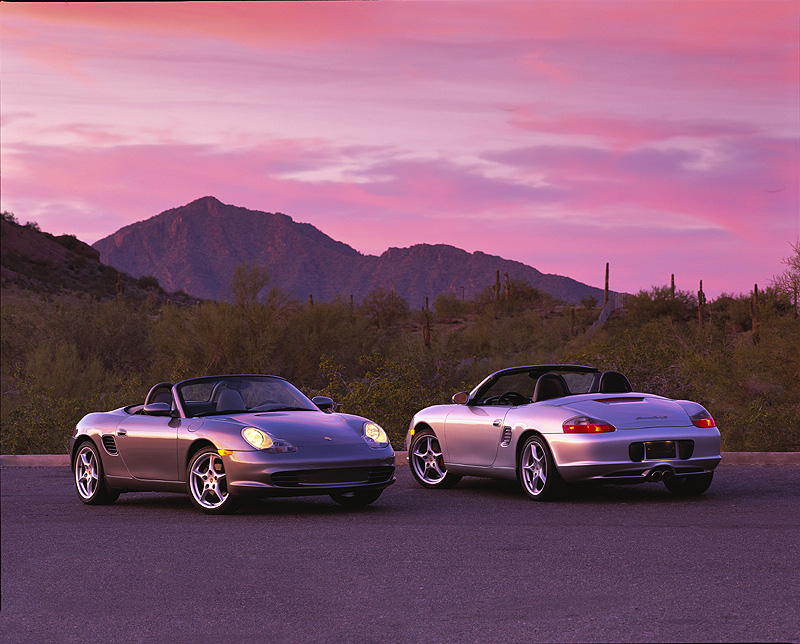
ATLANTA – With Porsche’s classic six-cylinder “boxer” engine architecture and roadster styling that recalls the proud heritage of such famous Porsche racers as the 550 Spyder and the RS60, the 2004 Porsche Boxster and Porsche Boxster S provide open road and open air fun for driving enthusiasts.
The Boxster was introduced as a concept car at the 1993 North American International Auto Show in Detroit and was an instant international sensation. Porsche took the car from concept to production for the 1997 model year, featuring Porsche’s new liquid-cooled boxer engine.
Porsche’s most ambitious hopes were to produce perhaps 15,000 units per year, but customer demand – especially for the higher performance Boxster S model that was introduced as a 2000 model – nearly doubled that production figure. The Boxster and Boxster S were significantly enhanced for the 2003 model year.
The evolutionary changes raised the performance through improved airflow management, better cooling and engine power upgrades. Both cars also feature a redesigned convertible top with a glass rear window and a built-in defroster.
New for the 2004 model year is an optional sports exhaust system for the Boxster S (U.S. market only). And, in the U.S. and Canada, two new exterior color choices for the Boxster and Boxster S: Atlas Gray metallic and Carmon Red metallic.

The 2004 Porsche Boxster is powered by a 2.7-liter, horizontally opposed, six-cylinder liquid-cooled engine that produces 225 horsepower (SAE) at 6,300 rpm and 192 lb.-ft. of torque at 4,750 rpm. Equipped with a standard five-speed manual transmission, the Boxster accelerates from a standing start to 62 mph (100 km/h) in only 6.4 seconds. With the optional Tiptronic® S five-speed automatic transmission, the sprint time is still a very quick 7.3 seconds.
Top track speed for the Porsche Boxster is 157 mph (253 km/h) with the manual transmission and 154 mph (248 km/h) with the Tiptronic S.
Despite such outstanding performance, the 2004 Porsche Boxster with the manual transmission has fuel economy ratings of 20 mpg city (11.4 liters/100km) and 29 mpg highway (7.4 liters/100km). The respective figures for the Tiptronic S-equipped Boxster are 18 mpg (13.3 liters/100km) and 26 mpg (8.3 liters/100km).
This combination of power and fuel efficiency is produced by Porsche’s patented VarioCam® Plus engine technology and Motronic ME 7.8 engine management controls.
VarioCam Plus responds immediately to driver inputs by making precise adjustment to intake valve opening and closing timing through technology that allows as much as 40 degrees of camshaft variation. This variation allows the engine to run with maximum efficiency whether driving slowly around town or hustling around a racetrack.
Motronic ME 7.8 engine management originally was developed for use on the 2000 Porsche 911® Turbo. It measures such parameters as engine speed, pedal position, engine oil and coolant temperatures and gear selection, then instantly calculates the requisite position for intake camshafts and synchronizes those camshafts on both rows of cylinders by adjusting the engine’s fuel/air mixture and ignition timing.
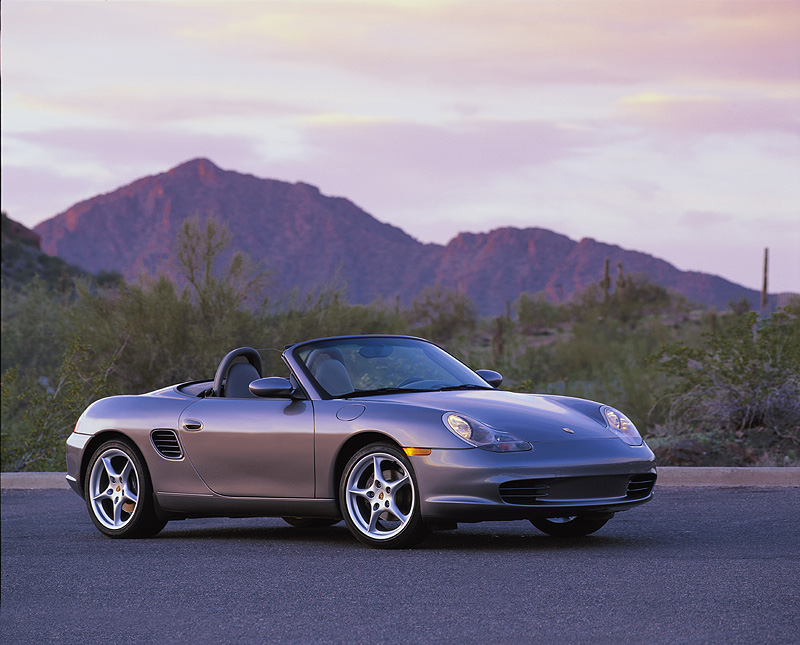
The engine in the 2004 Porsche Boxster also features a “returnless” fuel supply system that reduces hydrocarbon emissions caused when fuel is heated prematurely as it flows back and forth through a traditional delivery system. Porsche engineers developed a new and maintenance-free “returnless” system that incorporates the fuel pump, filter and pressure regulator inside the fuel tank. The result is that only the fuel that is actually needed for optimum combustion is pumped to the engine. Excess fuel does not enter the circuit and is not exposed to premature heating. The system provides a bonus for Porsche buyers because there is no need to replace the fuel filter as part of routine maintenance.
The engine in the 2004 Porsche Boxster also features a “returnless” fuel supply system that reduces hydrocarbon emissions caused when fuel is heated prematurely as it flows back and forth through a traditional delivery system. Porsche engineers developed a new and maintenance-free “returnless” system that incorporates the fuel pump, filter and pressure regulator inside the fuel tank. The result is that only the fuel that is actually needed for optimum combustion is pumped to the engine. Excess fuel does not enter the circuit and is not exposed to premature heating. The system provides a bonus for Porsche buyers because there is no need to replace the fuel filter as part of routine maintenance.
Boxster customers can choose between the precisely shifting standard five-speed manual and the optional Tiptronic S five-speed automatic transmissions. With Tiptronic S, the driver can place the shift lever into “D” and let the transmission do the shifting, or can shift into “M” and control gear changes with thumb switches mounted on the steering wheel.
In automatic mode, Tiptronic S uses one of several programmed shift maps to respond to driving style. For example, in leisurely travel, Tiptronic S up shifts early to provide a quiet ride. However, quicker stabs at the gas pedal call up a sporty shift program that holds gears longer for response and power. But even while in automatic mode, the computer-controlled Tiptronic S responds like a driver working a manual transmission, downshifting or holding lower gears when cornering and driving on hills. Tiptronic S also allows the driver to select manual mode simply by pressing an up- or downshift button, even if the shift lever is in the “D” position.
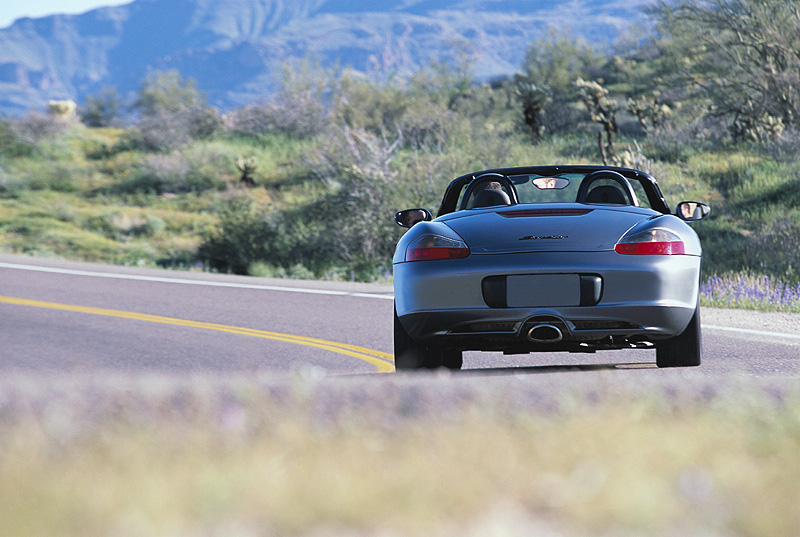
The 2004 Porsche Boxster’s racecar-inspired mid-engine layout concentrates the car’s mass near its center, providing quick response to steering inputs. Four-wheel independent suspension features a Porsche-optimized MacPherson-strut design for rigidity and uses aluminum components for low unsprung weight. Front and rear stabilizer bars and dual-tube gas-charged shock absorbers provide flat cornering. Power rack-and pinion steering yields a quick 2.98 turns lock-to-lock and a tight 35.8-ft. (10.9-meter) turning circle.
A “staggered” wheel/tire array with wider wheels and wider, lower-profile tires on the rear contributes to the sports car’s neutral handling characteristics. The standard aluminum alloy wheels measure 6 x 16 inches in front and mount 205/55 ZR16 tires; the 7 x 16-inch rear wheels mount 225/50 ZR16 tires. Optional 17- and 18-inch wheel/tire packages further enhance the already precise handling by reducing unsprung weight, thus assuring even smoother and more sensitive response from the shocks and springs.
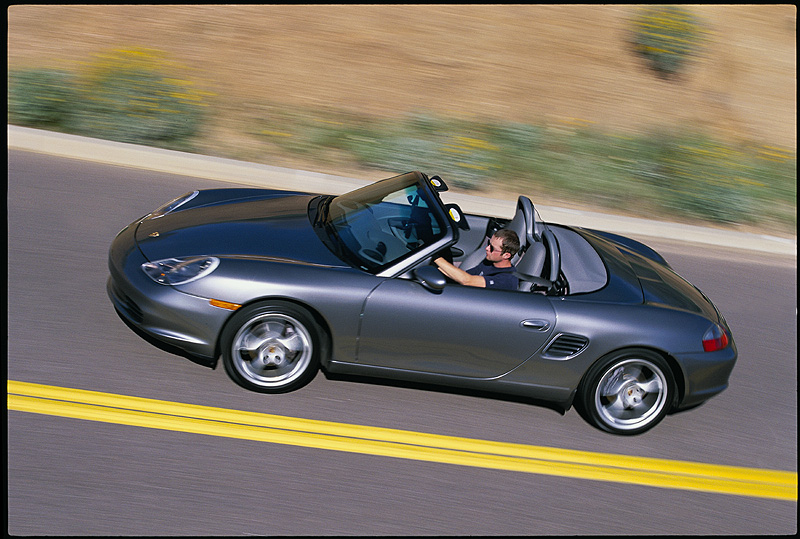
For even crisper handling, a sport suspension package is available with shorter and firmer springs, more responsive shocks and larger anti-roll bars.
The 2004 Porsche Boxster stops with four-wheel vented disc brakes with ABS 5.3 anti-lock braking system technology. Derived from the Porsche GT1 racecar, the Boxster’s one-piece “monoblock” brake calipers and four-wheel vented disc brakes reduce heat and unsprung weight. The front discs measure 11.7 inches in diameter and are 0.95-inch (298 mm x 24 mm) thick. The rear discs measure 11.5 inches in diameter and are 0.8-inch (292 mm x 20 mm) thick.
Porsche refined the Boxster’s body for the 2003 model year and those enhancements carry over for 2004. The enhancements include a new roof with a glass window and electric defroster, new lower front and rear fascia and a new rear spoiler. The fascia and spoiler changes improved the car’s aerodynamic efficiency by enhancing airflow to the engine, around the exhaust system and over a redesigned spoiler. Each change was a matter of style with substance.
Newly designed air intakes beneath the car’s front bumper, as well as similarly designed side scoops featuring body colored grille openings, are more effective at directing cooling air to the engine.
The Boxster’s power top, which opens or closes in 12 seconds, has a contoured appearance that is very similar to the sports car’s optional aluminum hardtop. When retracted, the rigid magnesium frame that forms the front edge of the roof provides protection for the glass window when the top is folded away just above the engine compartment.
When the top is up, the roof’s shape is designed to optimize airflow to the rear spoiler, which lifts automatically when the Boxster reaches 75 mph (120 km/h) for enhanced stability at higher speeds. The spoiler automatically retracts when the car slows to 50 mph (80 km/h).
Below the spoiler, the 2004 Porsche Boxster’s rear fascia is designed to channel cooling air around the car’s exhaust system. Meanwhile, careful design and engineering of the car’s muffler provide a strong “acoustic presence” that underscores the car’s power and performance potential.
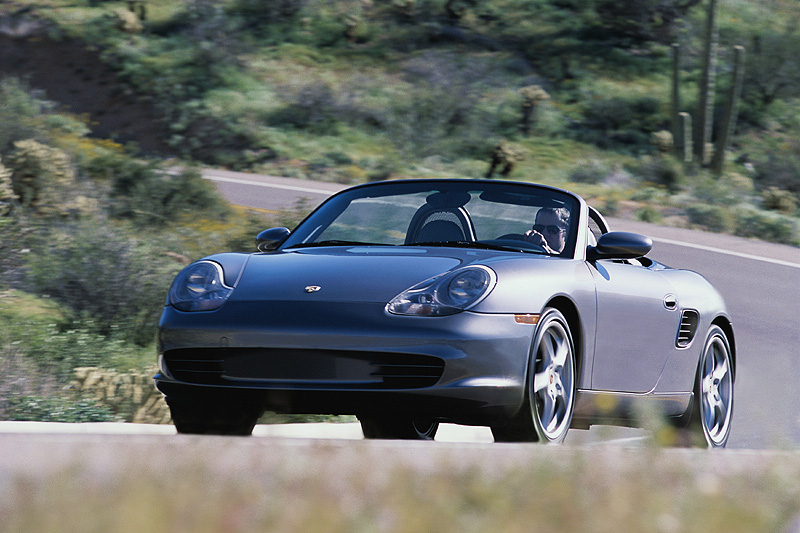
Safety in the Porsche Boxster starts with the body structure, which features front and rear deformation zones that protect a reinforced passenger compartment. Boron steel tubing reinforcements inside the windshield header and A-pillars along with supplemental safety bars behind the seats provide additional safety in the event of a rollover accident. The supplemental safety bars feature soft-touch covering for a high-quality appearance and tactile feel.
Supplementing the three-point inertia-reel seatbelts, the Boxster features seatbelt pretensioners and load limiters as well as dual front airbags and the Porsche Side Impact Protection System which includes door-mounted side airbags, boron-steel door reinforcement beams, and energy-absorbing door panels. The 30-liter capacity side airbags provide additional protection for the chest, head, and pelvis.
At a customer’s request, a U.S. Porsche dealer can install a system that deactivates the passenger airbags when a U.S. Porsche-approved child seat is used. The system features a cross brace with belt lock in front of the passenger seat. Buckling the special child seat into this brace deactivates the airbags. To activate the system, the dealer also must reprogram the airbag control module.
The optional Porsche Stability Management system (PSM) can help keep the car going in the direction the driver steers – on slippery or dry road surfaces. PSM uses data from several sensor inputs to detect a loss of grip at the front or rear. The system can reduce instability by applying braking to individual wheels and, if necessary, altering engine power. In addition, the PSM system also provides a traction control function on slippery surfaces.
The PSM system operates so quickly that most drivers likely will not feel it make corrections. The driver can disengage PSM with a dashboard switch. However, for safety, PSM will engage under braking and then disengage when the driver lifts off the brake. While the system provides dynamic handling aid, Porsche cautions drivers that PSM cannot counteract the laws of physics.
The 2004 Porsche Boxster comes equipped with extensive standard comfort and convenience equipment, including fog lamps, a heated windshield washer system, heated power side-view mirrors, a power top with glass rear window, remote door and front and rear trunk locks (with its mid-engine architecture, the Boxster has both front and rear trunks that offer a combined 9.1 cu.-ft. (258-liters) of storage space) and a transponder key anti-theft system with immobilizer.
Also standard are leather-faced seats with power recliners; leather-covered three-spoke steering wheel, gearshift knob, door armrests and handbrake handle; a telescoping steering column; one-touch controls to open or close the windows; automatic climate controls with a dust/pollen filter and charcoal odor filter; a digital radio with in-dash CD player; duel cupholders that pop out of the dashboard; a large, lighted and locking glove compartment with a 305 cu.-in. (5.0-liter) capacity; and LED interior orientation lights.
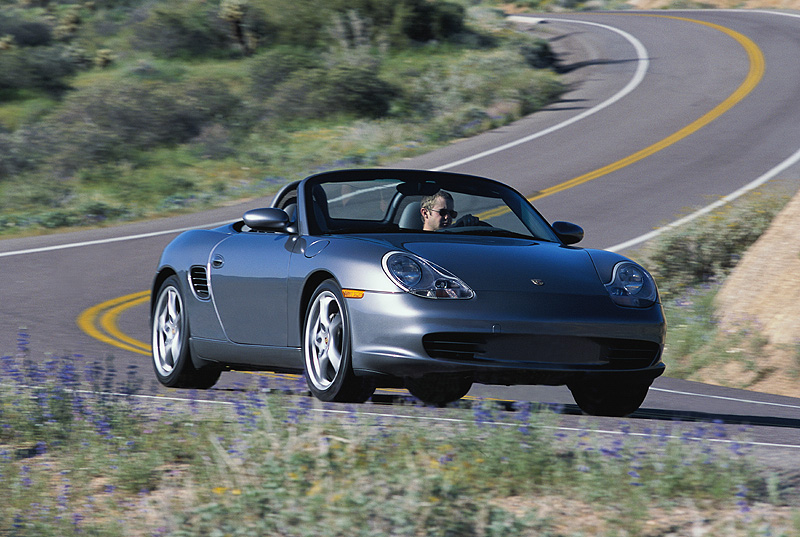
Optional equipment includes a Bose® digital sound system, Porsche Stability Management, leather upholstery, heated seats, Bi-Xenon headlights, a three-piece wind deflector, rear park assist, a navigation system and a removable aluminum hardtop.
The Bose audio system features equipment custom-engineered for the Porsche Boxster. The Bose automotive music system combines balanced stereo, a panoramic sound stage, deep bass and smooth frequency response to produce lifelike music reproduction even in the challenging environment of a car interior. The Bose sound system employs digital amplifiers to provide clean, uncolored sound at any listening level. In the Boxster, an array of 10 advanced loudspeakers blends seamlessly into cabin trim, raising and widening the sound stage and ensuring balanced stereo. Powerful bass speakers are concealed in customized enclosures to furnish superb performance within limited cabin space.
Porsche’s Communication Management system (PCM®) consists of a tuner, CD player, Global Positioning Satellite navigation system, and trip computer, all linked through Media-Oriented Systems Transport (MOST) digital databus. The MOST system incorporates light-wave conductors that exchange data between the individual components without loss of quality and at ultra-high speeds.
PCM includes a 5.8-inch (147 mm) color screen with its 16:9 aspect ratio and 12-position keyboard for easily and efficiently entering radio frequencies. The system assures excellent audio quality.
The navigation module provides features such as road junction zoom-in, dynamic navigation to avoid congestion, map scrolling so you can see beyond your current position, tour planning with the ability to memorize as many as eight destinations in a row and a CD-ROM system that can be used for the navigation system or for music.
The optional three-piece wind deflector reduces buffeting and noise during top-down driving. The optional aluminum hardtop is fully lined and includes a glass rear window with defroster. An innovative roof transportation system that attaches to the convertible roof (open or closed) or the optional hardtop also is available and is suitable for carrying skis, kayaks, bicycles or other equipment weighing as much as 165 lbs.
In addition to those options, the Porsche Exclusive program offers a wide array of optional features installed at the factory, including custom interior trim packages and individual trim items. The Porsche four-year/50,000 mile bumper-to-bumper warranty covers all Exclusive options, and Porsche dealers can include the cost of the options in the lease or finance contract.
The Tequipment (“Tech-quipment”) program offers a line of accessories available only from authorized Porsche dealers. Tequipment options include items such as special wheels, an aero body kit, instrument panel trim kits, CD changers, and custom floor mats. Customers can order Tequipment options at the time of purchase, or can return to the dealership for installation later.
While installation of Tequipment may require some modifications to the car, such modifications do not affect the standard limited warranty. Tequipment items come with a two-year warranty when installed by a certified technician at an authorized Porsche dealership.
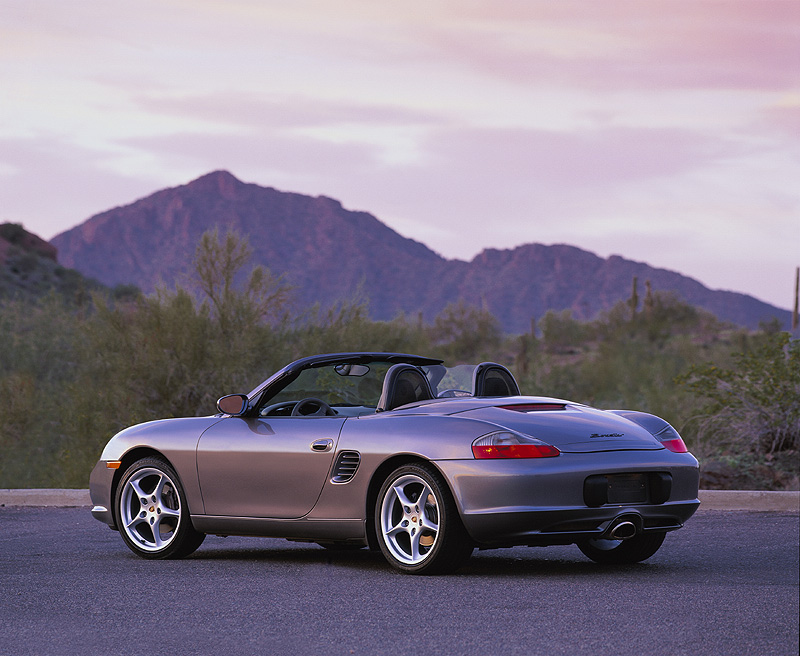
Every new Porsche car sold in the United States and Canada is covered by a four-year/50,000-mile (80,000 kilometer), bumper-to-bumper limited warranty, which includes Porsche’s roadside assistance program. The galvanized body and 26-step paint and anti-corrosion process enable Porsche to warranty each car against rust perforation for 10 years and unlimited mileage.
In addition, Porsche guarantees the paint finish for three years – also without a mileage limitation.
Porsche Cars North America, Inc. (PCNA), based in Atlanta, Ga., and its subsidiary, Porsche Cars Canada, Ltd., are the exclusive importers of Porsche vehicles for the United States and Canada. A wholly owned, indirect subsidiary of Dr. Ing. h.c.F. Porsche AG, PCNA employs approximately 250 people who provide Porsche vehicles, parts, service, marketing and training for its 204 U.S. and Canadian dealers. They, in turn, provide Porsche owners with best-in-class service.
.jpg)
.jpg)
.jpg)
PROVA BOXSTER 718 2.0 PDK

1999 - Boxster

Porsche Press kit

Porsche Literature

Our Porsche Cars